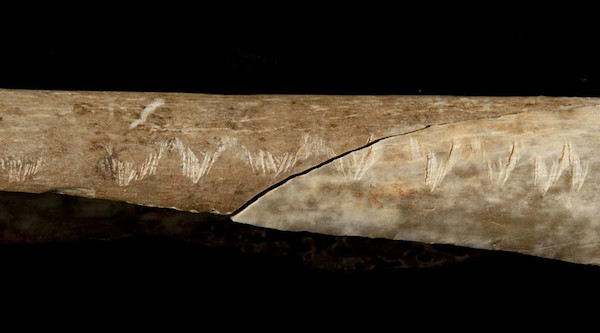Prehistoric cannibals who once lived in a Somerset cave engraved human bones with zig-zag designs as part of a “complex” eating ritual, according to new research.
The bones, which had a number of deliberate cuts and human teeth marks, were discovered at Gough’s Cave in the Mendip Hills and are believed to be between 12,000 and 17,000 years old – when the cave was occupied by Ice Age Britons.
Scientists from the Natural History Museum in London and University College London (UCL) compared hundreds of cut-marks found on human and animal bones in the cave. They discovered one human body with the bones separated, filleted, chewed and then marked with a zig-zag design, before it was finally broken to extract the bone marrow.
Researchers ruled out an initial theory that the marks were made during the butchery process, because they were found on a part of the bone with no muscle attachments. There is no indication on the skeletons that the humans had suffered violence before they died.
They concluded that the “zig zagging incisions are undoubtedly engraving marks, produced with no utilitarian purpose but purely for artistic or symbolic representation.”
The study, published in the journal PLOS ONE, says the marks may have represented the “story” of the victim’s life or a memorial to how they died. Whatever the reason, researchers agree it must have been part of a ritual or ceremony to mark the person’s passing, like modern day funerary rites.
“The sequence of modifications performed on this bone suggests that the engraving was a purposeful component of the cannibalistic practice, rich in symbolic connotations,” says Dr Silvia Bello, lead author of the study.
“Archaeologists have linked the engraving of objects and tools to ways of remembering events, places or circumstances, a sort of ‘written memory’ and ‘symbolic glue’ that held together complex social groups.
“Perhaps the engraving of this bone may have told a sort of story, more related to the deceased than the surrounding landscape. It could be that they are indicative of the individual, events from their life, the way they died, or the cannibalistic ritual itself.”
Gough’s Cave was first discovered in the 1880s and frequent excavations at the site found evidence that humans lived there for thousands of years, including “Cheddar man,” Britain’s oldest complete human skeleton, which dates from 7,150BC.
DNA taken from the skeleton was found to match that of Adrian Targett, a man living in the local area today.
The cave is 115 meters (377ft) deep and 3.405km (2.12 miles) long, and contains a variety of large chambers and rock formations.
Human bones have been found intermingled with butchered large mammal remains as well as flint, bone, antler and ivory artefacts, including a 13,000-year-old carving of a woolly mammoth.
The team has previously found skulls at the site which had been turned into bowls or cups, possibly to eat or drink from.
Complete Article HERE!


